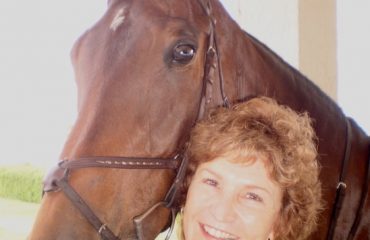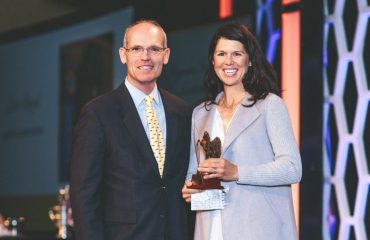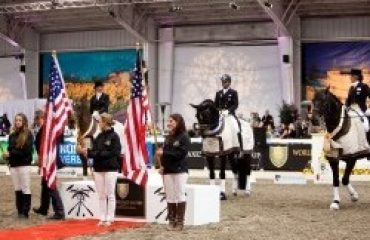 Richard Wheeler, DVM, was born in the U.K. and graduated from the Royal Veterinary College, London, in 2002. Dr. Wheeler then completed a two-year internship at Greenwood, Ellis and Partners (now Newmarket Equine Hospital) in Newmarket. In 2005, he moved to Wellington, Florida, to join Palm Beach Equine Clinic and he became a partner in 2009. Dr. Wheeler’s primary concentration is equine sports medicine. He is an FEI Veterinary Delegate for show jumping and dressage and has authored several published articles on the topic of equine sports medicine. Dr. Wheeler has served on the board of the USHJA Horse and Rider Advocates Committee. In 2016, Dr. Wheeler became a founding director of the Sport Horse Research Foundation. Dr. Wheeler and his wife, Jessica, have two children. Do you have a question you want Dr. Wheeler to answer? Send questions to editor@sidelinesnews.com.
Richard Wheeler, DVM, was born in the U.K. and graduated from the Royal Veterinary College, London, in 2002. Dr. Wheeler then completed a two-year internship at Greenwood, Ellis and Partners (now Newmarket Equine Hospital) in Newmarket. In 2005, he moved to Wellington, Florida, to join Palm Beach Equine Clinic and he became a partner in 2009. Dr. Wheeler’s primary concentration is equine sports medicine. He is an FEI Veterinary Delegate for show jumping and dressage and has authored several published articles on the topic of equine sports medicine. Dr. Wheeler has served on the board of the USHJA Horse and Rider Advocates Committee. In 2016, Dr. Wheeler became a founding director of the Sport Horse Research Foundation. Dr. Wheeler and his wife, Jessica, have two children. Do you have a question you want Dr. Wheeler to answer? Send questions to editor@sidelinesnews.com.
My show horse is getting older and beginning to experience arthritis. Are there any methods of controlling his arthritis to make him more comfortable?
Osteoarthritis is a common cause of lameness in horses of all disciplines. As with most pathology, arthritis can range in severity from very mild to severe. Treatment options often will vary both on severity and the use of the horse. Arthritis can follow an acute episode, such as trauma, or develop gradually as a result of mild repetitive trauma. In order to understand the process of arthritis, we must have knowledge of joint anatomy.
Generally speaking, joints are made up of bones covered with a layer of cartilage, separated by synovial fluid and supported by soft tissue structures, such as the joint capsule and ligaments. Their function is to allow movement and to dampen concussive forces. Osteoarthritis describes the degeneration of the joint components, most significantly articular cartilage.
My initial approach would be to establish an accurate diagnosis: which joints are involved and what the severity of the condition is. This can be achieved by a thorough lameness examination and nerve blocks, and then followed with diagnostic imaging techniques. Generally, radiographs and ultrasound are sufficient, but in some cases more advanced techniques such as nuclear scintigraphy, MRI and CT are necessary. It’s important to note that diagnostic imaging findings don’t always correlate well with lameness. I’ve seen many cases with significant radiographic evidence of arthritis that is well tolerated by the patient.
Once an accurate diagnosis is made, treatment options can be discussed. Treatment options are divided into systemic and local therapies: those delivered to the whole body or specifically to the area of concern. Systemic therapies include corticosteroids and nonsteroidal anti-inflammatory medications (NSAIDs), chondroprotective and anti-inflammatory products that can be administered orally and by injection. More recently, NSAIDs that selectively inhibit cyclooxygenase-2, such as firocoxib, have become available for use in horses; this aims to reduce the incidence of adverse gastrointestinal effects.
Systemic products used for the protection and promotion of cartilage and synovial fluid include polysulfated glycosaminoglycan, hyaluronic acid, chondroitin sulfate, glucosamine and resveratrol. These are available in various products formulated for injectable and oral use. Many of these formulations are formulated as joint supplements; given the lack of regulation, I recommend horse owners use caution, select products from reputable sources and seek veterinary advice.
Intra-articular therapies are commonly used in the treatment of equine arthritis. Initially, these usually consisted of corticosteroid and hyaluronic acid injections. More recently, various regenerative therapies have become available and while research is trailing their use, reports are very encouraging. I have discussed this in more detail in previous editions of Sidelines.
Other therapies to consider include extracorporeal shockwave therapy, therapeutic laser and acupuncture. As an adjunct to appropriate therapy, adjustments may need to be made with regard to the horse’s nutrition, shoeing and training regime.
In some cases surgical intervention can be of use, arthroscopy can be useful for diagnosis of subtle intra-articular lesions as well as the removal of bone fragments and debridement of soft tissue lesions. In severe cases, arthrodesis of some joints is possible as a last option for end-stage cases of osteoarthritis.
My vet recently told me that my horse had the beginnings of a quarter crack in his hoof. Do you have any tips about how I could treat his hooves, and prevent them from further cracking?
Quarter cracks are commonly seen in a variety of equine athletes and can result in lameness, bleeding, infection and reduced performance. They usually originate at the coronary band and extend distally (toward the ground); a true quarter crack will extend into the submural (inner) tissue of the hoof.
There are several causes of quarter cracks, including trauma and other underlying hoof conditions. In my experience, they are most commonly associated with underlying abnormal hoof conformation and/or an abnormal landing pattern of the hoof, both of which lead to abnormal loading forces through the hoof capsule.
In the acute phase, hemorrhage, pain and inflammation are addressed. Generally I try to reduce weightbearing forces through the heel quarter and treat the area topically. In some cases, nonsteroidal anti-inflammatory drugs (NSAIDs) and antibiotics may be indicated.
With regard to more long-term resolution, the first, and in my opinion most important step, is to address any underlying unbalance in hoof structure and loading. This will involve careful attention by your farrier and veterinarian. I would recommend hoof balance radiographs. Often, in these cases, we observe such conditions as sheared heels, abnormal heel conformation and improper landing. Such corrections may take time, and I generally recommend a hoof supplement to encourage hoof growth during this period.
There are many opinions regarding the best approach to addressing the hoof defect itself and I have seen successful outcomes with several techniques. In my opinion, the best approach is to stabilize the hoof capsule using a bar shoe and remove the shearing forces through the affected quarter by unloading the weight-bearing surface. In some mild cases, I’ve seen good resolution following rebalance and unloading of the quarter, without further intervention.
Some more significant cases may require further stabilization of the crack itself. Again, there are a variety of techniques and I’m not aware of one that is superior. The aim of the implant is to stabilize and reduce shearing forces through the crack. Common techniques involve suturing with wire, either drilled through the hoof wall or attached using screws either side of the defect; the application of an adhesive resin can add to the strength of the repair. It’s important that the product used is somewhat flexible to allow for normal hoof capsule movement and that it adheres well to the hoof wall.
However the quarter crack is repaired, it will take several months to grow out. The rate of resolution generally depends on how well the underlying cause has been resolved and the quality of the horse’s hoof growth. In many cases, it’s possible for the horse to continue exercise, often showing during the repair.













